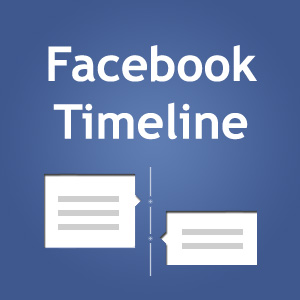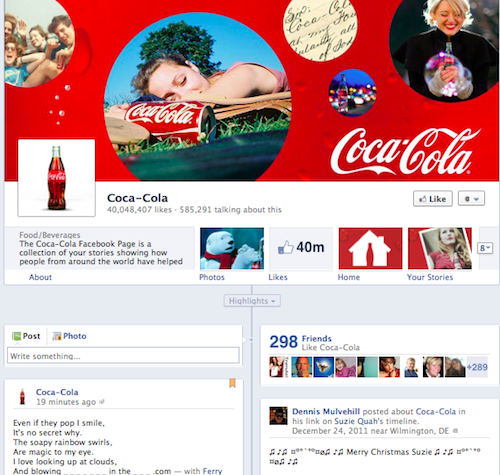 The Facebook Timeline Pages for Brands have officially rolled out. Let the social media complaining begin. But we think they present a great opportunity for a much improved brand presence on Facebook. We’ve been using Timeline personally since it rolled out and love it. Visually, it’s a huge improvement over the old Facebook pages and from a storytelling standpoint, much improved.
The Facebook Timeline Pages for Brands have officially rolled out. Let the social media complaining begin. But we think they present a great opportunity for a much improved brand presence on Facebook. We’ve been using Timeline personally since it rolled out and love it. Visually, it’s a huge improvement over the old Facebook pages and from a storytelling standpoint, much improved.
Speaking of storytelling, isn’t that pretty much what a brand’s real goal is on Facebook or other social media channels? Telling stories, encouraging friends to share their stories and experiences, engaging with brand advocates … yup, that’s brand storytelling. Tell me again what’s so bad about a Facebook timeline that not only encourages that but also makes the experience visually more interesting? Facebook’s all about the experience and we suspect these timeline changes are but one step of many to come that they hope will serve that goal.
Timeline for Pages: What’s the Big Deal?
As we already mentioned, Facebook’s Timeline for pages gives brands and businesses an exciting opportunity to tell a story. Need an example? Look at what Coke and Red Bull are doing—and now compare the vibrancy of those pages and the messaging to an “old” brand page by looking at Mercedes-Benz.
And one of the (many) cool things about Timeline is that it not only gives your brand a chance to tell a compelling visual story, but also an opportunity to share more of your company history with your audience by adding content to the page’s earlier Timeline years.
There are a number of other features worth exploring, too, such as “pinned posts,” which essentially take the place of a traditional landing page. Timeline milestones, as mentioned earlier, can showcase not just the history of your brand, but various achievements and accomplishments, too, which gives more of an impact to your overall brand story.
The Downside to Timeline
So, we like the new Facebook timeline—which is good, because it’s not like we have a choice. It represents a different set of opportunities for brands to expand and enrich their Facebook presence. Yet there are two sides to every coin, and Timeline for pages is no exception. This doesn’t create an “easy button” for brands hoping to use Facebook as a marketing channel. It changes the Facebook experience, and presents new, and different opportunities for brands to be doing what they should have been doing all along.
I can always count on my friend Brian Carter to provide a candid view of Facebook marketing, and his post “[RANT] Why Facebook Timeline For Pages Doesn’t Matter And You Should Get Back To Work” doesn’t disappoint. As you prepare to shift your page to the new format, you’ll want to be sure to carefully think through not only the elements you’ll use, but the information you want to incorporate and convey, too. And take Brian’s advice—he knows what he’s talking about.
That being said, don’t put all of your eggs in the Facebook basket, or spend time laboring over choosing cover photos instead of working on a compelling content strategy. Sure, Timelines are more visually appealing. Yet if you don’t deliver relevant and compelling content that matters to your audience, a photo or two won’t do much to boost your brand’s awareness and success.
“The real work is getting fans to see your posts, which happens if they like and comment on your posts,” writes Brian. “If you aren’t working hard on making your posts more interesting and getting more likes and comments, but instead, you’re anticipating how cool the Timeline will make the page look, you’re on the wrong track.”
After all, even some of the world’s biggest brands have a tough time with Facebook engagement, as illustrated in a great post by Ad Age Digital.
“Brands we think of as sexy have almost as tough a slog as laundry soap in getting their large fan bases to do something,” writes Ad Age’s Matthew Creamer.
The bottom line? Regardless of new, shiny features like Timeline for pages, you and your brand need to evaluate the cost of Facebook engagement and determine whether that investment is worthwhile when compared to the larger scheme of your digital marketing strategy. Facebook is a piece of a larger puzzle, and it doesn’t necessarily work for all brands and businesses. The ability to evaluate how Facebook can most effectively help you achieve your business goals is the key.
Converting to Timeline: A Checklist & Resources
If you admin a brand page, you’ll see a message at the top of your page that details the process. You’ll have until March 30 to make the switch to Timeline; after that, all pages will automatically be converted. Your changes won’t go into effect until you hit the “Publish Now” button, so you’ll have a chance to experiment with various page elements. As part of the message, you’ll also have the option to take a tour of the new features, and we recommend that you make time for the presentation.
As a result of Timeline, default landing tabs will no longer be available. You can still create a fan gate at a width of 810px, so keep that in mind as you consider your page changes.
There are additional factors to consider, too, including how to use your administrative dashboard, how Timeline impacts your work flow strategy and how to understand new features like “pinned posts” that essentially take the place of your page’s old landing tab. The always smart Beth Kanter has created a great checklist to help guide you through the transition and make sure you’ve covered all of your bases before you hit “publish.”
We also recommend downloading a copy of Facebook’s guide to Timeline for pages, which might be a handy reference as you plan and strategize. TechCrunch’s How to Use Facebook Timeline for Brand Pages is pretty awesome, too.
One last point: my team and I sat through a webinar on Tuesday about EdgeRank’s algorithm that was fantastic. And understanding EdgeRank and its secret sauce is an integral part of understanding how to effectively use Facebook as part of your social media marketing efforts and, more importantly, an engagement channel for your business. We’ll be writing about it soon, so if you’re interested in knowing more, subscribe to the blog so that you won’t miss it. As if I should have to tell you that!
Quit groaning about the extra work this will mean for you and get excited about it. Social media for brands—large or small—is marketing. Think about how you can use the new Timeline for brands to improve your brand messaging on Facebook and get more out of it. Change is hard. But if you’re a marketer or a business owner focused on marketing your business, it’s a given. Get used to it. Now go do something awesome with your brand pages.
Lead image via TechBend.com



